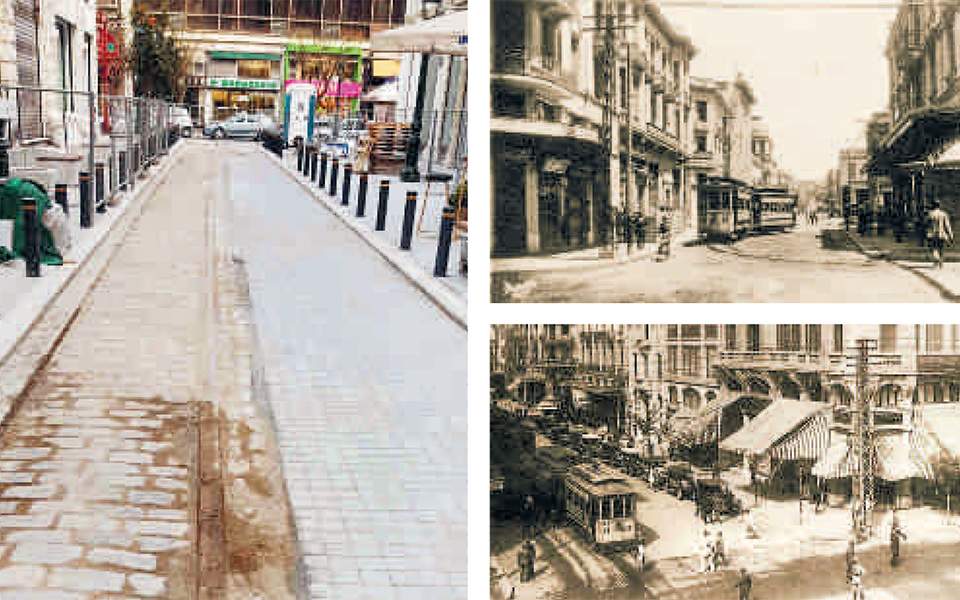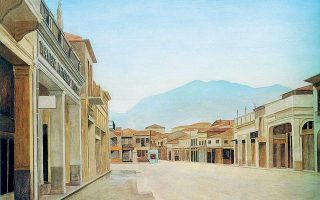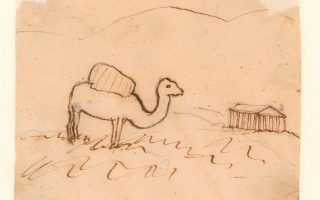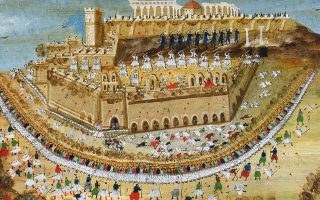The evolution of Aghiou Mina

Aghiou Mina Street in the northern Greek port city of Thessaloniki has its own history. It was written by Christians, Jews and Muslims, traders and bankers, travelers and the residents of this timeless city.
Known as Kapanaca in Turkish during the era of the Ottoman Empire, it was later renamed Ioanni Tsimiski when Thessaloniki came under Greek control in October 1912, and Aghiou Mina after French architect, archaeologist and urban planner Ernest Hebrard redeveloped the center of the city following the great fire in 1917.
This short picturesque street in the city’s historic center yielded a pleasant surprise during municipal work to convert Aghiou Mina into a low-traffic road. Beneath its asphalt surface, tram tracks and cobblestones were discovered that had remained hidden for 64 years.
The National Bank Cultural Foundation (MIET) and Cultural Center in Thessaloniki seized this opportunity to recount the history of the street in an event at the MIET bookshop (11 Tsimiski Street). The venue is important. The very same location, whose main entrance is on Tsimiski Street, has a second door on Aghiou Mina, right across from the Jewish Museum, and was the site of the first branch of the Banque d’Orient (Bank of Anatolia), a subsidiary of National Bank of Greece (NBG).
It was a glorious building with pediments and statues of Hermes, a basement treasury, and a beautiful oval trading room with by 12 columns that supported a glass roof. The building, erected in 1924, no longer exists. It was demolished in 1963, but its architectural plan, which is on display in the exhibition, has been preserved.
Focusing on the findings and the building, the director of the city’s MIET Cultural Center, Ioannis Epaminondas, has set up an atmospheric backdrop to portray “the transformations of the road from Kapanaca to Aghiou Mina Street,” as the exhibition is titled, using maps, postcards, photos and floor plans of the building to illustrate the evolution of the bank district from the late 19th century to the present day.
“During the times of the Ottoman Empire, Kapanaca Street was a main thoroughfare,” Epaminondas told Kathimerini. “It started from Emporiou (Commerce) Square and ended up in today’s Fanarioton Square, crossing the city diagonally.” With the urban plan drafted by the Ottoman administration after the fire of 1890, the burnt section of the street was straightened, he explains. After a new plan that followed the devastating fire of 1917, only a small section of the old Kapanaca remained, stretching from Venizelou Street to Emporiou Square.
At the start of the 20th century, the city’s second economic center gradually formed around Aghiou Mina Street. The first was in the so-called “Frangomahala” district (the area now known as Chrimatistiriou Square), where Jewish and Ottoman banks were located. This second center was where Greek lenders such as Viomichanias, Athinon, Thessalias, Emporiki, NBG, the country’s central bank and the Banque d’Orient (which was absorbed by NBG in 1932) opened their doors.
Despite the whirlwind of reconstruction, today Aghiou Mina Street bears visible traces of its past, mainly through its buildings, with the Jewish Museum of Thessaloniki being a reference point. This is where the tram turned around from Tsimiski into Venizelos Street, entering Aghiou Mina and continuing its journey on Tsimiski toward its depot (the end of Line 1). When the tram ceased operating after 61 years (1893-1954), the tracks were removed – first on Tsimiski Street in the same year and then on Egnatia Street in 1957.
The tracks on Aghiou Mina were covered by asphalt, thus preserving a segment of modern historical memory. After they re-emerged, the original study for the redevelopment of the street (funded by the Stavros Niarchos Foundation) was modified, and the Ephorate of Modern Monuments approved a proposal to keep them visible as a reminder of the first chapter of Thessaloniki’s urban transport and the city’s mutation as part of its modernization.
The exhibition will remain on display until July 27. The MIET bookstore is open Mondays and Wednesdays from 9 a.m. to 3.30 p.m., Tuesdays, Thursday and Fridays from 9 a.m. to 8 p.m. and Saturdays from 9.30 a.m. to 4 p.m.





